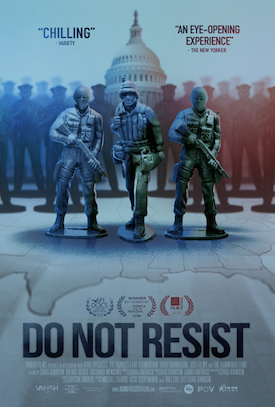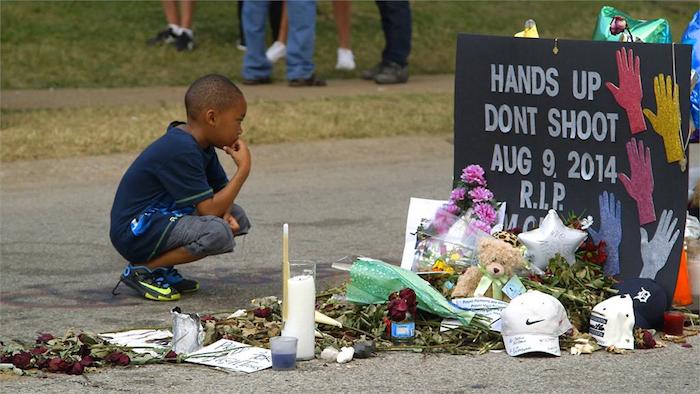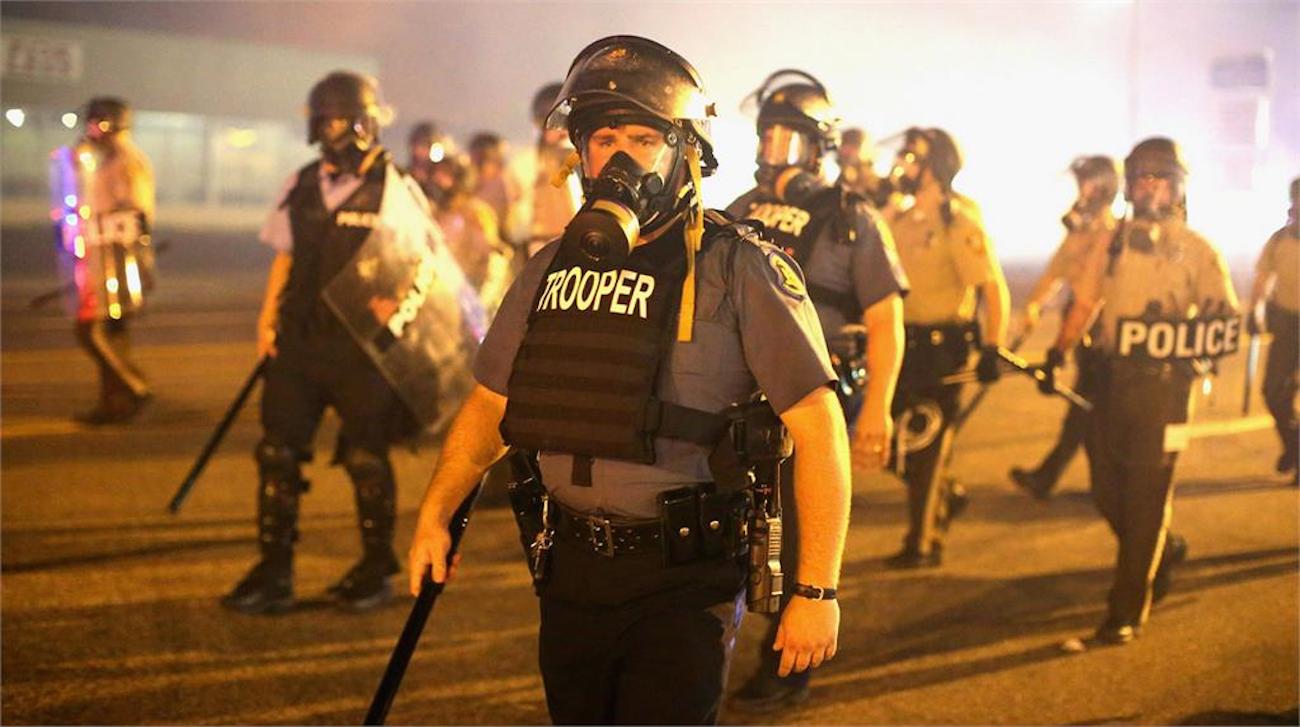 This timely film offers a stunning behind-the-scenes look at the current state of policing in America as well as a glimpse into its future. Opening on startling footage of police action during the protests in Ferguson, Missouri, the film then broadens its scope to present scenes from across the country — a conference presentation where the value of high-end weapons technologies is presented to potential police buyers, a community that has just received its very own military-grade tank, and a SWAT team arriving at a home to execute a warrant. The cumulative effect of these vignettes paints a potentially troubling picture of the direction our local law enforcement agencies are headed and emphasizes the need for continuing discussions among police officers and local communities about how to best protect and serve while building greater trust. I sat down with director Craig Atkinson to talk about this powerful new documentary.
This timely film offers a stunning behind-the-scenes look at the current state of policing in America as well as a glimpse into its future. Opening on startling footage of police action during the protests in Ferguson, Missouri, the film then broadens its scope to present scenes from across the country — a conference presentation where the value of high-end weapons technologies is presented to potential police buyers, a community that has just received its very own military-grade tank, and a SWAT team arriving at a home to execute a warrant. The cumulative effect of these vignettes paints a potentially troubling picture of the direction our local law enforcement agencies are headed and emphasizes the need for continuing discussions among police officers and local communities about how to best protect and serve while building greater trust. I sat down with director Craig Atkinson to talk about this powerful new documentary.
Danny Miller: I was shocked to see footage in this film that made even small towns in America resemble a police state. I can only imagine the effect of that on communities that already feel on guard in the presence of the police.
Craig Atkinson: Yeah, the optics of it is really abrasive. Even the opening shot of the film where you see a full-blown SWAT team that could take rounds in the chest and survive — a team that looks like something straight out of Falloujah — standing there watching the protesters in Ferguson. That sends a very clear message to the community, it’s such an eyesore. This is not how it used to be during protests in the past. The police departments might have had have plainclothes officers among the protesters at first and then, if necessary, a presence of uniformed officers as well. Depending on the situation, they might have considered placing riot officers and SWAT teams around the corner or in some way out of view in case anything went wrong but they would never have the the community be confronted by that from the get-go. But that’s what happened in Ferguson. They had all of this high-powered equipment with very little training, and the moment the protest kicked up, they met the community with the greatest weaponry available.
That seems like literally the worst way to approach such a situation.
It is the worst. From the tactical position of a police officer, you’re trying to de-escalate a crowd situation, but when you meet them with such full force, you immediately identify a target for protesters to rally against. I mean, who wouldn’t feel that way against an occupying force?
It’s so interesting to see this in the film from both sides. It doesn’t seems like the individual officers are at fault, just that the overall system is out of control.
I’m glad to hear you say that, I was certainly never trying to make a film that condemned the police. From my experience, they often seem like they’re trapped in the middle. A lot of police officers sign up to protect and serve but then they’re given these top-down objectives that completely put them at odds with their community.
What was your initial vision for this film?
My father was a police officer for 29 years right outside of Detroit, and then a SWAT officer for 13 years. When I saw the reaction to the Boston Marathon bombing, I was amazed at the level of sophisticated equipment those SWAT teams had at their disposal. My dad retired in 2002 and by 2013 things had changed pretty dramatically, mostly because of all the post-9/11 financing — about $39 billion that was gifted to law enforcement. In my father’s era, SWAT teams were used for only the most violent of circumstances — a barricaded gunman or active shooter, for example — whereas now SWAT has become a routine part of police work. I was curious to know how that had happened. I thought I would be able to show the full range of a SWAT team’s experience. I look at what happened after the Pulse Nightclub shooting in Orlando as a very good use of a SWAT team — they took an armored vehicle, punctured a whole in the side of the building, and freed hostages. That’s a fantastic use of SWAT, using these vehicles for what they were intended.
But that doesn’t describe how most SWAT teams are used today?
No, that’s the exception now. All of the raids I went out on during the course of making this film were for drug search warrants —nothing to do with violent offenses. I thought throughout the course of a three-year project and doing these multiple ride-alongs that I would see the equipment used properly at least some of the time, but that wasn’t the case. Not only were we aggressively raiding homes just for drug search warrants, we hardly ever found anything — one time there was a bowl of weed, another time a gram and a half of weed. This is happening around the country. The people in the homes think they’re being attacked so they grab a firearm to see who’s robbing their home and then they’re arrested for that or shot and killed. Can the family sue the police? No, because the individual was pointing a gun at police officers! Even if the SWAT team was in the wrong home, which happens a lot, too, there’s really no retribution that the family can hope for.
Wow. When you talked to officers after these raids, was there any acknowledgement that the use of force was a little over the top?
The first thing we’d always hear back at the police station after a raid was, “Did we seize anything? Did we seize anything?” The motivation was always how much money was found during the raid. That’s what’s happening on a regular basis, these teams are going out and seizing assets. That gentleman that got his $800 taken in the film, that was seized in what’s called a “civil assets forfeiture” which basically means your property is guilty until you’re proved innocent. The presumption of guilt has been shifted.
What happened to that guy?
He got out the next day. I asked him if he was going to try to get his money back and he said no, that getting a lawyer would probably cost $2500 or more so it just wasn’t worth it to fight it in court. So what happens time and again is that the money seized just goes back to the police departments.

It seems like a prescription for bad relationships between police and local communities.
Exactly. How much ill will are you creating in these communities when you’re running into these homes like an occupying force and then only finding drugs only about 50 percent of the time? This is an area that desperately needs reform. In my Dad’s era of SWAT, they’d have to do extensive research before the SWAT team could go into a home. If I came into your home, I knew I could arrest you based on my investigation, but that has completely shifted.
What did they have on that guy that you show in the raid?
Instead of doing any kind of investigative research, it was an informant. Someone saying, “Johnny down the street is selling weed,” so they say, “Okay, let’s go raid Johnny’s house.” When you’re using informants who, as you know, are often trying to get out of charges themselves, they’re hardly a reliable source. I felt so bad for the kids that were in that house. What is the long-term effect of children being exposed to that king of occupying force?
And it can escalate so quickly. If that happened to me, I’m sure I would be extremely upset and it would probably look like I was resisting and then there’d be the justification for using even more force.
Yes. And it’s all about seizing the assets — I think that’s the most glaring fact that this film portrays. Most of these officers are nice people but they are being given this objective to go out and raid these homes for the purpose of raising revenue. And so, again, the officers are often caught in the middle. Or the departments are too eager to use all of their military-style equipment. When you see the shield bump between the two officers in Ferguson, you can see that this is just another day in the life of these officers. And then they shoot tear gas into a crowd of women and children. To me, it just speaks to a massive disconnect.
Do you worry that this film could be perceived as “anti-police?”
Actually, I’m encouraged that it seems to be the opposite. We’ve been showing it at police academies and police stations. We just showed the film at the Criminal Justice College that is a feeder school for the NYPD. There were 300 people in attendance including many active NYPD and afterwards they got up and thanked us for making the film, they said it reflects reality and the areas in their work that need reform. One NYPD SWAT officer got up and immediately tried to put distance between what the NYPD does and the way Dave Grossman teachers officers that you see in the film. We were just down in Dallas and had a screening with the officer who was the head of the command that lost those five officers a few months ago and he said he thought the film was a very powerful teaching tool and that it should be seen in police academies. We’re not condemning the officers in the film, but we are looking at the style of policing that needs to change.
The militarization of the police is almost comical when you see these small Mayberry-like towns where there’s never been a murder getting these gigantic powerful surplus tanks.
I’m not a technophobe by any stretch of the imagination, I’m excited about the future of technology including in law enforcement. The thing is, it just needs more thought. The technology itself is benign, it’s just how we use it — it can be used for good or for bad, We need carefully thought out policy and guidelines for its use.
What do you hope people will take away from the documentary?
The film gives people the opportunity to go beyond the headlines that they’ve been seeing since Ferguson, to experience what it actually looks like and feels like to be in communities that have been under this kind of siege. There are many officers who have been working towards reform but they also meet a lot of resistance. I hope the film also serves as an example and a tool for those people.

